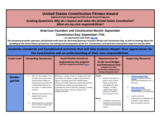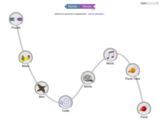
Wakelet collection on 3D printing resources
- Subject:
- Educational Technology
- Professional Learning
- Material Type:
- Lecture Notes
- Provider:
- Utah Coalition for Educational Technology
- Date Added:
- 03/13/2023

Wakelet collection on 3D printing resources

This article describes covert and overt active engagement strategies for use with elementary students. Find the Question templates are included for use with informational text.

This article discusses the four forms of identifying similarities and differences: comparing, classifying, creating metaphors, and creating analogies and how these strategies can be used in an elementary classroom.

This is an optional program for use by Utah LEAs, schools, and teachers to observe Founders Month and Consitution Day. It aligns with and supports mastery of many Utah Core Social Studies Standards in grade K-5. Standards alignment is provided, along with resources for possible use.

This article includes links to expository text for students in grades K-1, 2-3, and 4-5 about the climate differences between the Arctic and Antarctica.

This issue of the free online magazine, Beyond Penguins and Polar Bears, explores the amazing birds that live in or migrate to the polar regions. The issue was co-produced with the Cornell Lab of Ornithology. In addition to content knowledge articles and lesson plans, the issue includes information about bird-themed citizen science programs from the Cornell Lab of Ornithology.

This article assembles free resources from the Arctic and Antarctic Birds issue of the Beyond Penguins and Polar Bears cyberzine into a unit outline based on the 5E learning cycle framework. Outlines are provided for Grades K-2 and 3-5.

This article discusses how to use murals as an interdisciplinary, cooperative activity to blend science, art, and math concepts.

This article provides an overview of using rubrics as a method of assessment and discusses technological tools that facilitate the creation of rubrics.

This article reprints and links to informational text about the adaptations that allow mammals and fish to survive in polar oceans. Versions are available for students in grades K-1, 2-3 and 4-5. Related science and literacy activities are included.

This article includes links to expository text for students in grades K-1, 2-3, and 4-5 about the aurora.

This article lists seven art techniques and four poetry types that can be used to depict and describe the aurora.

This article provides a brief discussion of the importance of teaching students to analyze data and representations of data as well as two resources that can help teachers implement these strategies into their instruction.

This article features children's literature about arctic, Antarctic, and migratory birds.

Help early education students explore simple block coding through interactive games.

This article provides links to six web sites that provide an overview of cause/effect relationships, graphic organizers, and teaching strategies for elementary teachers.

This article assembles free resources from the Climate Change and the Polar Regions issue of the Beyond Penguins and Polar Bears cyberzine into a unit outline based on the 5E learning cycle framework. Outlines are provided for Grades K-2 and Grades 3-5.

This article provides five strategies for building the foundation for climate science literacy in the elementary grades.

This article describes common misconceptions held by elementary students about the history of the polar regions, fossils, and geologic time. The article provides ideas for formative assessment, teaching strategies, and the National Science Education Standards.

This article describes some common misconceptions that elementary students may have about oceans. It also includes suggestions for formative assessment and teaching for conceptual change.